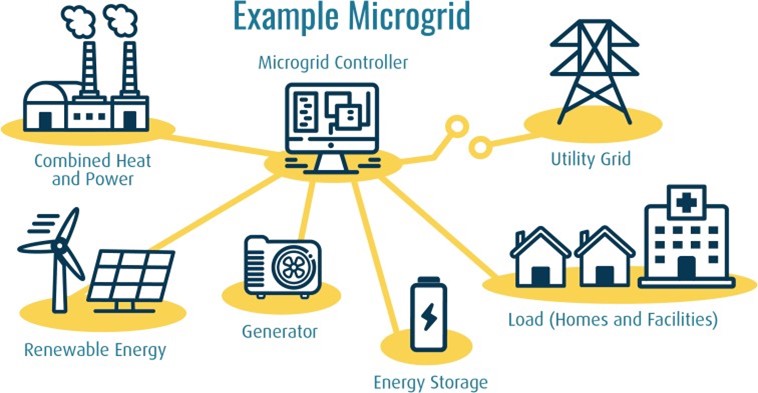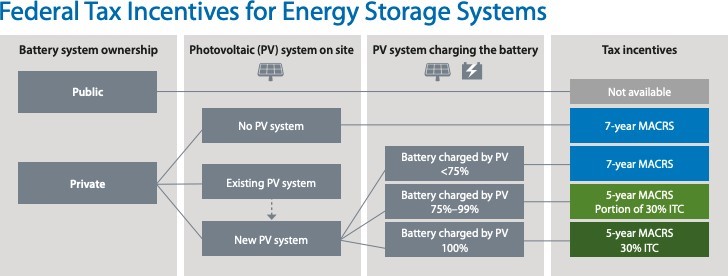A Guide to Green Energy Adoption for Transit Agencies Chapter 3: Microgrids for Zero-Emission Vehicles
- Date: February 13, 2022
Jump to section
Transit agencies are expected to provide cost-effective, reliable service across a variety of conditions. Operating zero-emission buses does not change this basic mandate for agencies. Ensuring that consistent energy is being provided to zero-emission bus (ZEB) fueling infrastructure is crucial to meeting service requirements.
A failure of the electric grid, whether brief or extended, negatively impacts an agency’s reliability for their ZEB fleet. Depending on the local conditions for an agency, there may also be challenges to bringing the necessary amount of electricity to a depot to power ZEB fueling infrastructure. And utility rate structures can be organized in ways that can result in significant cost increases or savings when fueling ZEBs compared to traditional vehicles fleets.
Microgrids
A microgrid is one possible solution for transit agencies to address these challenges. The Department of Energy defines a microgrid as:
- A group of interconnected loads and distributed energy resources within clearly defined electrical boundaries that acts as a single controllable entity with respect to the grid.
- Capable of connecting and disconnecting from the grid to enable it to operate in both grid-connected or island mode.
No single microgrid looks exactly the same, but all microgrids include the following components:
- Energy generation
- Energy storage
- Microgrid controller
- Utility service disconnect

Energy Generation
Traditional microgrids, such as a hospital using a diesel generator to provide electricity during a power outage, have operated primarily with fossil fuels. However, as outlined in Chapter 2 of this guidebook, the falling cost of solar photovoltaics (PV) has made this green energy technology a cost-competitive solution for green energy generation. The combination of no fuel costs and minimal operation and maintenance costs make solar PV an appealing option for energy generation as part of a microgrid. Solar PV can provide energy directly to the electric grid, energize a lithium-ion battery energy storage system (BESS), or power an electrolyzer to produce green hydrogen to store on-site. As discussed in Chapter 4: Procurement Options for Green Energy, different payment structures for the energy provided by solar PV have different impacts on the financial feasibility of the overall microgrid system.
Energy Storage
Microgrids using fossil fuels as the primary energy source have the advantage of being able to store energy in the form of liquid or gaseous fuel for long periods of time. For microgrid systems utilizing intermittent sources of green energy, such as wind or solar PV, battery storage is required. Lithium-ion batteries are the most common form of stationary storage, making up more than 90% of the total worldwide installed capacity for large-scale battery storage (EIA, 2020).
Their prevalence is due in large part to cost decreases of 80% between 2010 and 2017 (Mongird, et al., 2019).
Microgrid Controller
The defining characteristic of a microgrid is its ability to operate independently from the electric grid, a process known as “islanding”. A microgrid controller provides a number of services, including:
- Frequency and voltage regulation
- System monitoring
- Distributed energy resource (DER) coordination
- Islanding and reconnecting the microgrid to the electric grid
Microgrid controllers are the component of a microgrid with the most variation in cost. A 2018 study by the National Renewable Energy Laboratory (NREL) found in a survey that among 21 microgrid projects, controllers made up anywhere from 0.5%-21% of total project costs with a median of 7% of total costs ($155,000/MW) (Giraldez, Flores-Espino, MacAlpine, & Asmus, 2018). NREL did find that costs showed a downward trend as project sizes reached and exceeded 2 MW in total size.
Utility Service Disconnect
To safely ‘island’ from the grid, a service disconnect must be opened at the site’s utility entrance substation to separate the microgrid from the main utility grid. Disconnection may be necessary to prevent the flow of electricity out into the grid, ensuring the safety of both grid infrastructure and utility workers who may be servicing that infrastructure in the case of a widespread power outage. The microgrid controller is often responsible for automatically engaging a microgrid’s islanding capabilities via the transfer switch that disconnects the microgrid from the electric grid.
Project Considerations
While microgrids have been successfully deployed across the country, transit agencies are still in the early stages of determining how microgrids can provide value to their operations. There is no one-size-fits all approach to developing a microgrid project that will satisfy every agency’s needs. However, the following elements should be considered by any agency deciding whether to move forward on a microgrid project.
Understand Energy Needs
The overall design of a microgrid should take into account the energy profile of the infrastructure for which it is providing services. For agencies integrating ZEBs into their service, the decision to pair microgrid resources with charging infrastructure will be influenced by the number of buses being charged and time of day during which they’re charged. Other factors to consider will be an agency’s electric rate structure and whether certain times of day have higher energy consumption charges.
Agencies will also need to balance current and future energy needs when determining the proper size of a microgrid. This information is especially important for those agencies who plan to grow the share of ZEBs in their fleet over time, which may require additional energy infrastructure needs both for the microgrid and supporting utility infrastructure. Factors to consider include:
- Upfront capital costs for the microgrid system
- Planned growth for the ZEB fleet
- Short and long-term energy needs to reliably meet service requirements
- Short and long-term utility infrastructure upgrades needed to support additional ZEB service
Coordinate with the Utility
Local utilities will play a crucial role in ensuring a microgrid project is able to connect and provide services to the electric grid. Transit agencies seriously considering a microgrid project should engage with their utility company early on in the project development process and continue engagement throughout the design and implementation phases. Early engagement will allow agencies to understand whether utility infrastructure upgrades or additions are necessary to facilitate interconnection to and islanding from the electric grid. Understanding these additional costs early provides a clearer picture for an agency as it continues to develop the project. Utilities may also offer financial incentives for the installation of green energy generation or storage to help offset some of the upfront project costs.
An agency can also engage with its utility to explore opportunities for electric rate structures that better suit their operational or financial needs. Agencies planning to primarily charge buses during times when the overall demand on the electric grid is low may find that utilities will be willing to offer time-of-use rates. Time-of-use rates assign different electricity prices during different times of the day and/or year. Time-of-use designations are generally assigned to Peak (high grid demand) or Off-Peak (low grid demand) periods, along with designations for Summer and Winter.
Determine Space Constraints
As discussed in Chapter 2: Green Energy Infrastructure, green energy infrastructure can be designed in different ways to accommodate space constraints. Agencies with outdoor bus parking can explore solar carports to utilize yard space, while large indoor facilities may be better suited for rooftop solar PV. Battery storage systems take up roughly 1 parking space per megawatt-hour (MWh) of storage capacity.
Engage Reliable Partners
Agencies may determine that engaging with one or more companies in a public-private partnership (P3) to help finance, develop, operate, and maintain their microgrid makes the most financial sense. Pursuing a partnership with an organization well-versed in successfully taking microgrid projects through the project lifecycle will increase the likelihood that an agency develops a system that best suits their needs and takes advantage of all available financial incentives.
Explore Financial Incentives
In addition to utilities, federal, state, and local government agencies offer financial incentives to help facilitate new green energy construction. It is important for agencies and project partners to evaluate how changes to assumptions on available financial incentive programs can impact long-term contracts for green energy infrastructure.
The two primary federal incentives are:
Investment tax credit (ITC)
- Allows the owner of the solar PV and/or battery storage system to deduct a percentage of the cost of the system from their federal taxes
- Public entities are not eligible for the ITC but can partner with a private developer and receive the benefits of the ITC passed down through to the overall cost of the system.
Modified accelerated cost recovery system (MACRS)
Tax incentive that allows the owner of an asset to recover the cost of business or income-producing property through deductions for depreciation

An updated list of green energy incentive programs at the state and local level can be found through the Database of State Incentives for Renewables & Efficiency (DSIRE), which is maintained by North Carolina Clean Energy Technology Center at North Carolina State University.
Alternative Resilience Options
A microgrid project may not be a suitable financial fit in the short-term for agencies primarily focused on operational resilience, especially if the agency has low electricity rates or faces a challenging regulatory or permitting environment. In the long-term, microgrids may become more amenable to agencies if green energy continues to decrease in cost and more state and local jurisdictions become familiar with the processes by which a microgrid can be integrated into the existing energy system. Alternative options for agencies seeking more immediate resilience for their operations, including those looking for backup power sources for ZEB fueling, include bringing dual power feeds into the depot facility and coordinating with local partners to utilize existing fueling infrastructure.
Dual Power Feeds
Dual power feeds allow an additional, independent electricity path to provide power to a facility. Requests for dual power feeds are not uncommon for utilities, as certain customers require an additional layer of resilience in the event of one power feed failing. However, this additional supply path does come with additional costs, which can be significantly increased in the event a utility line extension is needed. A dual power feed also requires additional equipment, which can be a challenge depending on space constraints.
Alternative Fueling Locations
The deployment of zero-emission vehicles across both public and private fleets, in addition to the general public, will necessitate a continued increase in the number of zero-emission vehicle (ZEV) fueling stations in communities over time. Transit agencies deploying ZEBs can coordinate with local partners to determine how this existing charging infrastructure could support some or all of a fleet’s deployment needs during a localized power outage impacting their fueling facility. It is important for transit agencies to coordinate with their vehicle manufacturers to confirm that their vehicles are compatible with the specific makes and models of any alternative charging infrastructure being considered.
Making Microgrids More Accessible
Microgrids have historically been used by critical services and infrastructure to support operations during unexpected power outages. However, as the cost of green energy and energy storage has decreased in recent years, public and private organizations have found opportunities to deploy microgrids. Services provided by these microgrids include increased resilience, utility cost savings, and greenhouse gas emission reductions from their operations.
While transit agencies are still in the early stages of understanding how microgrids can support their operations, the resilience and business case can continue to become more achievable for agencies if green energy costs continue to decrease over time.
The next step to make microgrids more accessible for all organizations will be for specific microgrid components and project development costs to decrease and become more predictable across different states and localities. Utilities will also continue to play an important role in any expansion of microgrid deployments, ensuring that grid interconnection processes and infrastructure are in place to successfully operate a microgrid. For more information on working with the local utility, please see N-CATT’s whitepaper, Building Successful Partnerships between Rural Transit Systems Deploying Zero-Emission Vehicles and their Electric Utilities.